The times they are a-changin’. As Gen Z and millennial generations continue to enter the workforce, sales leaders face new employees with entirely different expectations and goals.
Although sales organizations traditionally maintained a formal separation between leaders and team members, the younger workforce desires a closer working relationship, greater transparency, and open communication.
Sales operations technology trends are changing how sales teams work, from automating mundane tasks to using AI-based insights to help uncover new opportunities. Companies can increase efficiency and revenue by leveraging sales technology and creating a more engaging environment for employees.
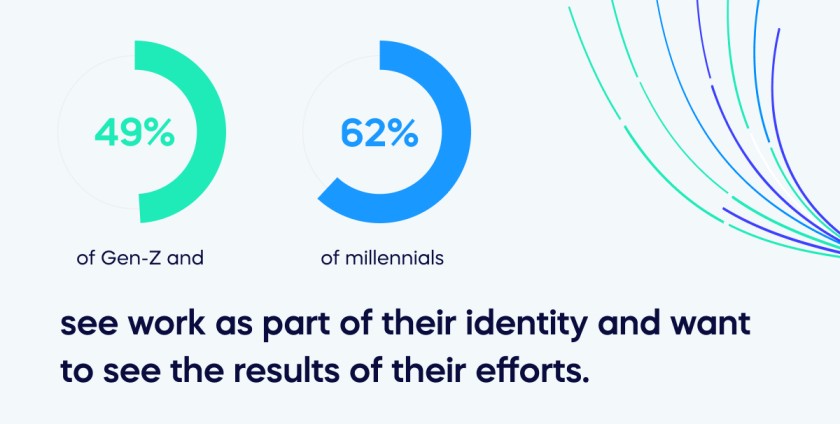
49% of Gen Z and 62% of millennials see work as part of their identity and want to see the results of their efforts. Sales leaders must acknowledge these changes to be successful.
Today, successful sales leadership requires striking the right balance between solid mentorship and coaching while focusing on fulfilling business goals and meeting quotas.
To help explain the emerging priorities of successful sales leadership, we will explore the following topics:
- What is sales leadership?
- Why is sales leadership important?
- What are the emerging priorities for sales leadership?
- How can you develop the best sales leaders?
What is sales leadership?
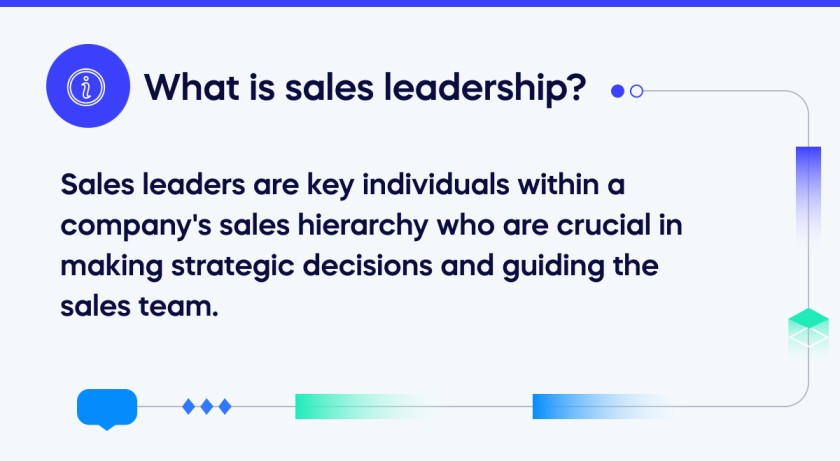
Sales leaders are key individuals within a company’s sales hierarchy who are crucial in making strategic decisions and guiding the sales team. Typically, the visionary leadership holds positions like VP of Sales, Sales Director, or Chief Revenue Officer (CRO).
They achieve this through a combination of:
- Sales coaching.
- Utilization of sales tools.
- Development of sales strategies.
- Overall motivation to drive success.
As a sales leader, you are responsible for analyzing the market and making data-driven decisions. Furthermore, imparting your wisdom and experience to your sales team is crucial, nurturing their skills and motivating them towards success.
Why is sales leadership important?
In today’s business landscape, the role of sales leadership has become vital in driving sales effectiveness.
Sales managers who actively engage their sales teams, exhibit practical coaching skills, and lead with a systematic sales approach achieve remarkable outcomes. These include higher win/loss ratios, increased revenue, and reduced salesperson turnover.
Influential sales leaders recognize that navigating this emotional rollercoaster is crucial to their role. They provide salespeople with focus, direction, and the tools to build a highly effective sales team.
What are the 5 emerging priorities for sales leadership?
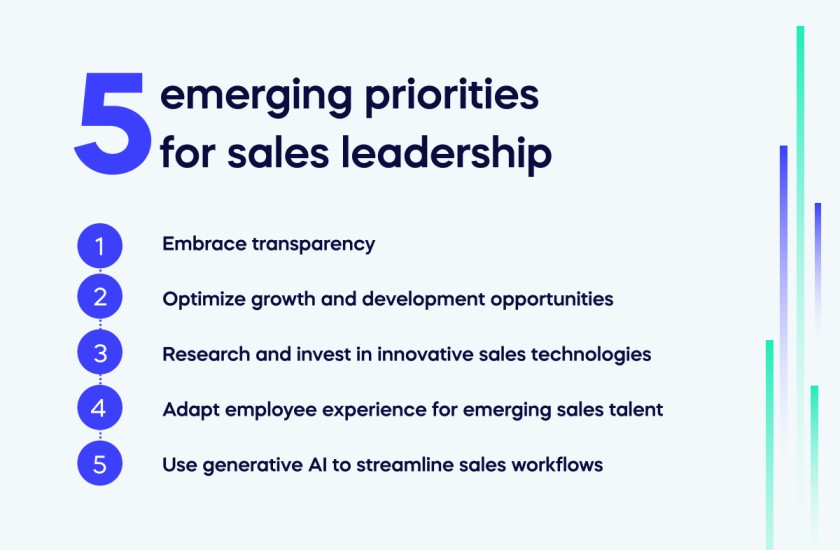
Let’s check out the five emerging priorities for sales leadership to help you acquire and implement the sales leadership skills you need to succeed.
Priority #1: Embrace transparency
The old corporate model lauded an authoritative sales leader who made unilateral plans and shared very little with their team. However, salespeople are often more motivated by their leaders and sales managers when they become part of decision-making.
Collin Cadmus, VP of Sales at Aircall and one of many great sales leaders, shared his experience as a young sales executive in a high-tech company on an episode of The Sales Hacker Podcast.
Cadmus consistently receives skeptical feedback from his more traditional contemporaries, who tell him he is too open with his team. His response? “I know. And that’s why we’re crushing it.”
His decision to share information with his team about his challenges and obstacles as a sales director is not the norm. Yet, his team’s success speaks for itself as he demonstrates transparency as one of the great sales leadership skills.
Visionary sales leaders who clarify the purpose of the sales strategy and even solicit input from their team glean the benefits of more brainpower, different perspectives, and, most importantly, higher engagement from their sales reps.
Successful sales leaders who aren’t afraid of transparency demonstrate no shame in receiving help from the team, cultivating a culture of collaboration, shared success, and trust throughout their sales organization.
Priority #2: Optimize growth and development opportunities
Beyond the short-term goal of reaching quotas, today’s sales workforce emphasizes continual development and growth.
Employees want to be empowered and feel part of something important and meaningful.
Avner Baruch, Head of International Sales Enablement at WalkMe, says the shifting expectations of millennials are causing sales leaders to transform their mindset on sales leadership.
The younger generation expects a higher level of personal satisfaction from their work. For managers and executives, this means entrusting employees to take risks, giving them meaningful work, and investing in their growth.
That’s why Avner always looks for engaging ways to provide practical training, create interactive presentations, and deliver personalized feedback.
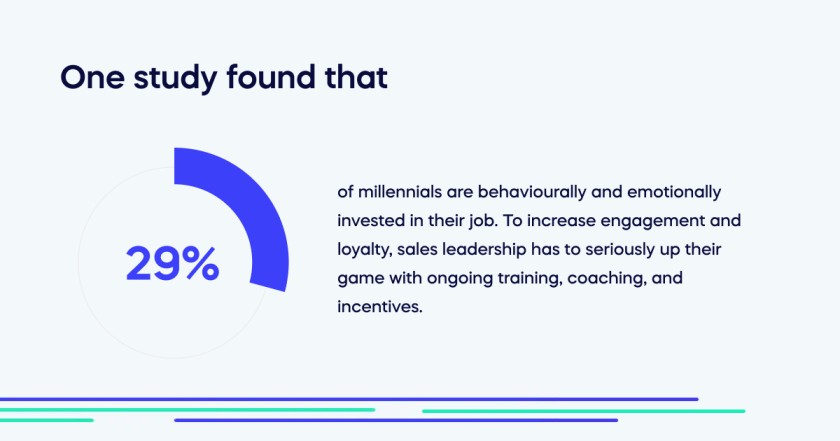
One study found that 29% of millennials are behaviourally and emotionally invested in their job. To increase engagement and loyalty, sales leadership has to seriously up their game with ongoing training, coaching, and incentives.
The most significant incentive for sticking around is seeing that there’s room to grow. When employees are encouraged to take on more responsibilities and climb the ranks, their trust and commitment to the organization grows.
Priority #3: Research and invest in innovative sales technologies
Sales technologies create endless opportunities to boost productivity and improve performance on both the team and individual levels.
Yet essential sales technologies, such as Salesforce, ServiceNow, and other CRMs, are often poorly utilized by the sales team. Limited usability means your team misses the system’s full benefits.
Overcoming this usability challenge requires a strategic and robust approach to software onboarding and continual retraining.
Traditional training methods, such as in-person classroom sessions or webinars, don’t promote long-term knowledge retention, and they’re ill-equipped to support users in the face of automatic updates and new feature releases.
With digital adoption solutions (DAS), you can be confident that your sales team members receive tailored, real-time guidance whenever needed to complete any process quickly and efficiently.
Other tools are also helpful, like Gong, which records, categorizes, and analyzes every sales conversation. Gong allows sales leaders and reps to access all their team members’ interactions with leads.
The conversations are indexed, organized, and customized for easy access. This data provides important insights that sales leaders can use to deliver specific feedback and analytics on sales reps’ performance.
Priority #4: Adapt employee experience for emerging sales talent
Sales leaders must adapt employee experience for the emerging sales talent in the Gen Z and millennial age groups.
The best ways to achieve this involve four factors:
- Flexibility: Millennials and Gen Z feel remote or hybrid working arrangements should be standard. Offer such options to attract and retain sales staff.
- Inclusivity: Foster a strong culture of inclusivity to attract diverse sales talent.
- Purpose: Conduct regular pulse surveys to ensure sales staff feel their tasks are purposeful.
- Social media: Engage in marketing to attract Gen Z and millennial talent to your sales team.
Showing Gen Z and millennials you care about their experiences will drive collaboration success, leading to higher employee experience for your sales team.
Priority #5: Use generative AI to streamline sales workflows
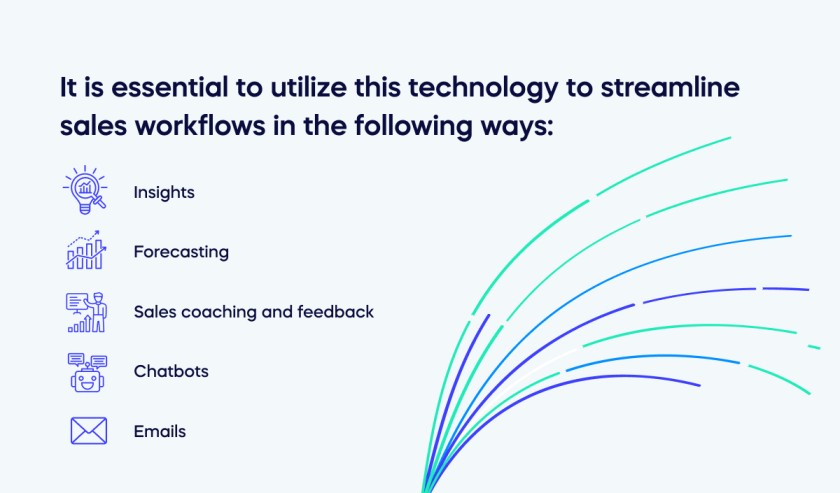
85% of sales professionals feel that generative AI, like ChatGPT, makes their prospecting efforts more effective. It is essential to utilize this technology to streamline sales workflows in the following ways:
- Insights: AI can generate insights faster than manual processes.
- Forecasting: Use AI for data-based predictions for future sales trends.
- Sales coaching and feedback: AI can collect sales call data for individual and team feedback.
- Chatbots: Use a chatbot for rapid customer issue resolution.
- Emails: Utilize AI to craft personalized emails for cold outreach rapidly.
Use these priorities within your sales organization’s sales strategy to ensure success as part of your leadership approach.
It is also essential to continue researching new priorities as new technologies emerge, allowing you to optimize and adjust your approach to align with marketplace changes to go from a good to a great sales leader.
How can you develop the best sales leaders?
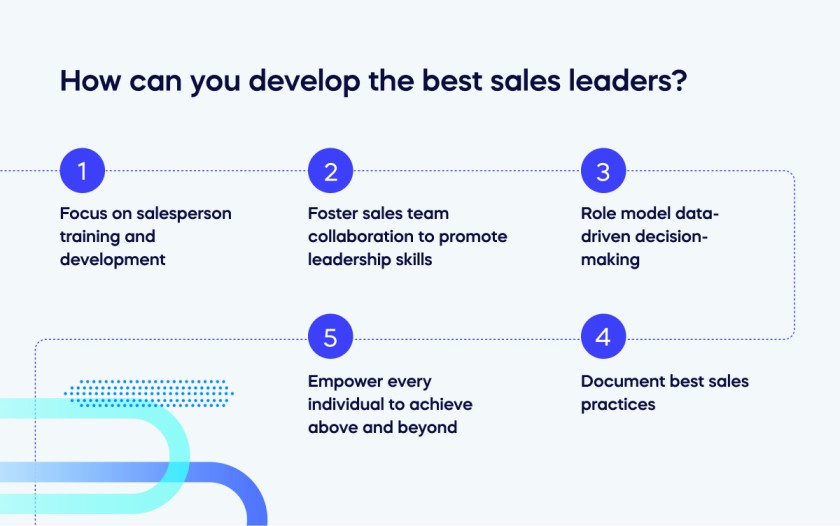
Developing exceptional sales leaders requires a multi-faceted approach that blends education, empowerment, and collaboration for the sales team as they seek promotion to sales management to become the best sales leaders.
Focus on salesperson training and development
Firstly, fostering a culture of continuous learning and development is essential. Sales leaders should regularly organize seminars and workshops to share their knowledge and experience with the team.
These interactive sessions, featuring role plays and discussions, enhance skills and help identify future leadership potential within the ranks.
Investing in a performance support system takes training a step further. This tool equips salespeople with on-demand, context-sensitive resources, improving their adoption of processes and tools.
Interactive content like in-app guidance and smart tips ensure effective problem-solving within the workflow while providing leaders with insights into team engagement and skill gaps.
Foster sales team collaboration to promote leadership skills
Collaboration is key to goal setting. Involve your team in the process, discussing achievable targets and necessary KPIs. Transparency empowers them to take ownership of their objectives and aligns everyone toward shared success.
Role model data-driven decision-making
Data-driven decision-making is paramount. Infuse sales analytics across the organization to set goals, shift strategies, and make informed hiring choices. By grounding decisions in facts, emotions are minimized, and plans are more effective.
Document best sales practices
Documenting best practices and processes solidifies standards and creates accountability. An employee sales training handbook acts as a reference, ensuring uniformity and preventing excuses for failure.
Empower every individual to achieve above and beyond
True leadership empowers individuals. Train salespeople to be self-reliant and confident in closing deals while being a supportive resource. This autonomy frees leaders to focus on strategic tasks while cultivating a team capable of independent success.
The journey toward exceptional sales leadership involves a dynamic mix of education, technology, collaboration, data, documentation, and empowerment. By embracing these strategies, you’re nurturing a team that meets and consistently exceeds targets.
Use a DAP to steer your sales leader ship
Imagine you’re steering the ship as a sales leader, charged with navigating your team through choppy waters toward success. This journey demands direction and the right tools to ensure smooth sailing.
Think of a digital adoption platform (DAP) as the ultimate GPS for your sales tech landscape.
A digital adoption platform is also your ace for consistency, like having a playbook that everyone follows. You can document best practices, set standards, and even hold your team accountable for following your established processes.
Simply put, a digital adoption platform is your partner in crime for sales leadership. It empowers your team, gives you data-driven insights, and ensures everyone’s playing by the same rulebook.

